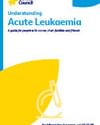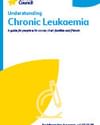What is leukaemia?
Leukaemia is cancer of the white blood cells, which begins in the bone marrow.
It starts when the body makes too many immature white blood cells (blast cells). These abnormal blast cells are known as leukaemia cells. They multiply out of control and continue to divide but never mature into normal cells.
Because the leukaemia cells are immature and abnormal, they don’t carry out the usual infection-fighting function of white blood cells. They also crowd out normal white blood cells, which then can’t work properly. This increases the risk of infections. When the bone marrow fills with leukaemia cells, there is little room for healthy red cells and platelets to be produced.
Leukaemia’s are grouped in two ways: the type of white blood cell affected – lymphoid or myeloid; and how quickly the disease develops and gets worse. Acute leukaemia appears suddenly and grows quickly while chronic leukaemia appears gradually and develops slowly over months to years.
This information refers to four types of leukaemia:
Acute Lymphoblastic Leukaemia (ALL)
Normal lymphocytes fight infection. When you have acute lymphocytic leukaemia, the lymphocytes can’t function properly, and you may develop a serious infection. The disease also causes many abnormal lymphocytes to be produced, crowding out the normal red blood cells and platelets.
Acute lymphocytic leukaemia is most common in children. However some adults develop this type of leukaemia. About 370 people are diagnosed each year.
This is sometimes called ‘lymphoblastic’ leukaemia.
Chronic Lymphoblastic Leukaemia (CLL)
This leukaemia also affects the lymphocytes, but usually develops much more slowly than acute lymphocytic leukaemia.
The disease progresses slowly, so the normal cells aren’t crowded out as rapidly as in the acute type of the disease. If you have chronic lymphocytic leukaemia, you may not feel any symptoms until the later stages of the disease. In some cases, symptoms never occur because the disease progresses so slowly.
This disease affects adults and doesn’t occur in children. CLL is the most common type of chronic leukaemia, with about 1600 people diagnosed each year.
Acute Myeloid Leukaemia (AML)
This is the most common type of acute leukaemia in adults, with about 1050 people diagnosed each year.
Acute myeloid leukaemia mainly affects the myeloid cells known as granulocytes, but also red blood cells, platelets and monocytes. The disease creates too many young myeloid cells and not enough mature myeloid cells. The young myeloid cells can block blood vessels.
Chronic Myeloid Leukaemia (CML).
Chronic myeloid leukaemia can occur at any age, but is uncommon below the age of 20 years.
Too many myeloid cells are present. Chronic myeloid leukaemia occurs in two stages: first, there’s a slow multiplication of abnormal cells. Then, it can quickly change into an acute stage. About 320 people are diagnosed with CML annually.
What are the symptoms?
Symptoms for CLL and CML
Many people with chronic leukaemia have no symptoms. Often the disease is diagnosed after a routine blood test shows a high white blood cell count. In the early stages, symptoms tend to be mild and develop slowly.
- swollen lymph nodes in the neck, underarms or groin
- pain and/or feeling of fullness in the abdomen after eating only small amounts – caused by an enlarged spleen
- tiredness – caused by a lack of red blood cells
- frequent and persistent infections – caused by a lack of normal white blood cells leading to lowered immunity
- bruising or bleeding – caused by low levels of platelets
- excessive sweating at night
- high temperature (fever) without any other signs of infection
- weight loss
Symptoms for AML and ALL
Occasionally, a person will have no symptoms or vague symptoms such as an ongoing cold, and the leukaemia is discovered during a routine blood test. However, many people with AML find that some of the following symptoms appear quickly over a few weeks.
- Fatigue or other signs of anaemia
- Increased bruising and bleeding
- Repeated or persistent infections
- Enlarged spleen and lymph nodes
Less common symptoms of leukaemia include bone or joint pain, swollen and tender gums, skin rashes, headaches, weight loss, vision problems, vomiting and chest pains.
What are the risk factors?
Acute Leukaemia (AML and ALL)
The cause of acute leukaemia is unknown, but factors that put some people at higher risk are:
- previous treatment with chemotherapy or radiation therapy
- exposure to intense radiation
- exposure to certain chemicals, such as benzene, petroleum products, paints, certain pesticides and heavy metals, over a long period of time.
- certain genetic disorders such as Downs syndrome
- viruses like the Human T-Cell leukaemia virus.
Chronic leukaemia (CML and CLL)
Chronic leukaemia is caused by changes to one or more of the genes that control the growth and development of blood cells. These changes happen over time, but it is not known why they occur in some people and not others. Exposure to some chemicals or high doses of radiation has been linked to developing leukaemia, but this doesn’t explain most cases.
How is leukaemia diagnosed?
If you have symptoms of leukaemia , or if you have a test for another reason and it suggests leukaemia, your general practitioner (GP) will do a physical examination, organise further tests and may refer you to a specialist called a haematologist.
Blood tests
Your doctor will take a blood sample to see how well your blood, kidneys and liver are working, and to check your general health.
Bone marrow biopsy
Blood cells develop in your bone marrow, so your doctor will want to check a sample of your bone marrow for signs of leukaemia. During the biopsy, the doctor uses a thin needle to remove a small amount of bone marrow, usually from your hipbone (pelvic bone). You will be given a local anaesthetic to numb the area, pain relief or light sedation to help you feel relaxed.
The bone marrow sample (biopsy) is sent to a laboratory, and a specialist called a pathologist will view the sample under a microscope to work out the subtype of leukaemia. Doctors use this information to suggest the most suitable treatment.
Imaging tests
You may have one or more of the following to find out more about the leukaemia and to check your general health:
- chest x-ray
- CT (computerised tomography) scan
- PET (positron emission tomography)-CT scan
- Ultrasound
- MRI (magnetic resonance imaging)
The staging, classification and prognosis of leukaemia
Staging
The tests undertaken to diagnose leukaemia help your specialist work out how far the cancer has spread. This is known as staging, and it helps your health care team recommend the best treatment for you.
AML
There is no standard staging system for AML.
The disease is described as:
- untreated,
- in remission
- recurrent.
ALL
Working out the subtype of acute lymphoblastic leukaemia (ALL) is called classification. It helps doctors to plan treatment and work out prognosis. ALL is divided into several subtypes according to the type of lymphocyte (B-cell or T-cell) that has become abnormal.
CML
is described in three phases:
- chronic – a few blast cells are found in the blood and bone marrow
- accelerated – after a few years the leukaemia may suddenly change and grow quicker
- blast – the number of blast cells increases, causing symptoms to worsen. Blast cells often spread to other organs.
CLL
There are two staging systems commonly used for CLL: the Binet system and the Rai system.
In Australia, most doctors use the Binet system.
The Rai system divides CLL into five stages and separates these stages into low-risk, intermediate-risk and high-risk groups. It is used mainly in the United States.
Binet staging system
Stage A – There are a high number of white blood cells but fewer than three enlarged areas of lymph tissue (lymph nodes, liver and/or spleen).
Stage B – There are a high number of white blood cells and three or more enlarged areas of lymph tissue.
Stage C – There are a high number of white blood cells with a low number of red blood cells (anaemia) and/or platelets (thrombocytopenia), and enlarged lymph nodes or spleen.
Prognosis
Prognosis means the expected outcome of a disease. You may wish to discuss your prognosis with your doctor, but it is not possible for any doctor to predict the exact course of the disease. Instead, your doctor can give you an idea about the general prognosis for people with the same type and stage of cancer.
To come up with a prognosis, your doctor will consider:
- test results
- the type of leukaemia you have
- the rate and extent of growth
- other factors such as age, fitness and medical history
These details will also help your doctor advise you on the best treatment options.
Treatment for leukaemia
Treatments will depend on the type of leukaemia you have.
Acute lymphoblastic lymphoma (ALL)
The most common form of treatment for ALL is chemotherapy. Chemotherapy uses drugs to kill or slow the growth of cancer cells while doing the least possible damage to healthy cells. Chemotherapy is given through a liquid drip into a vein (intravenously), an injection into a muscle or as tablets. You will probably have chemotherapy as a course of several sessions (cycles) over approximately 6 months. Your cancer specialist will explain your treatment schedule.
Treatment for ALL can be divided into three phases:
- Induction therapy –This is a quick and intensive course of treatment aimed at bringing about, or inducing, a remission. It will require you to be admitted to hospital.
- Post-remission (consolidation) therapy – If remission is achieved following induction therapy, additional treatment is required soon after in order to help destroy any remaining signs of ALL in your body. This is usually delivered in treatment ‘blocks’ over several months.
- Maintenance therapy – This treatment generally takes place for several months and is aimed at keeping you in remission and preventing future relapse.
Acute myeloid lymphoma (AML)
The most common form of treatment for AML is chemotherapy, which is aimed at inducing remission by destroying all signs of leukaemic cells in the blood and bone marrow.
If remission is achieved, a form of post-remission treatment is often given as a way of stopping the leukaemia returning. Several factors will determine the type of post remission treatment you receive, including:
- the type of disease involved;
- how well it responded to induction therapy;
- your age;
- and your general health.
While a good number of AML patients will achieve remission, some will relapse which can affect additional treatment.
Relapsed AML is often more resistant to treatment, so if you have not had an allogenic transplant (a stem cell transplant using marrow collected from a matched and healthy donor) this treatment option will be considered.
Chronic lymphocitic leukaemia (CLL)
Often people with CLL will have no symptoms and will not require treatment, particularly in the early stages.
It is only once the CLL progresses, is advanced or causes symptoms that treatment starts, which for most, is after many years.
The most common forms of treatment include:
- Chemotherapy – a combination of anti-cancer drugs given through a drip into a vein (intravenously), an injection into a muscle or as tablets over several cycles and accompanied by rest periods.
- Monoclonal antibody therapy – this treatment works by intravenously transfusing monoclonal antibodies which support your own immune system to recognise CLL cells as foreign and kill them. Improved results have recently been achieved through combining a monoclonal antibody like alemtuzumab or rituximab with chemotherapy.
Chronic myeloid leukaemia (CML)
There are a number of treatment options for CML, and the treatment you are given will depend on a number of things, including:
- The phase of your lymphoma
- How old you are
- Your overall health
Generally, the treatment offered to most people with CML is a type of drugs called tyrosine kinase inhibitors (TKIs). These drugs are often very effective at controlling CML through blocking enzyme activity to prevent the growth of leukaemic cells. In most cases, people will need to take TKI medication for life.
Life after treatment
For most people, the cancer experience doesn’t end on the last day of treatment. Life after cancer can present its own challenges. You may have mixed feelings when treatment ends and worry that every ache and pain means the cancer is coming back.
Some people say that they feel pressure to return to ‘normal life’. It is important to allow yourself time to adjust to the physical and emotional changes and establish a new daily routine at your own pace. Your family and friends may also need time to adjust.
Cancer Council 13 11 20 can help you connect with other people who have had cancer and provide you with information about the emotional and practical aspects of living well after cancer.
Follow-up appointments
Whether treatment ends or is ongoing, you will have regular appointments to monitor your health. During these check-ups, you will usually have a physical examination and you may have blood tests, x-rays or scans.
How often you will need to see your doctor will depend on the level of monitoring needed for the type and stage of the leukaemia. Between follow-up appointments, let your doctor know immediately of any health problems.
What if the cancer returns?
For some people, leukaemia does come back after treatment, which is known as a relapse or recurrence. It is important to have regular check-ups, so that if cancer does come back, it can be found early.
Leukaemia that has relapsed can still be treated, with the aim of causing remission or relieving symptoms. Treatment for recurrence usually includes further chemotherapy, targeted therapy and sometimes with radiation therapy. If the cancer is more advanced or aggressive, your doctor may recommend a stem cell transplant combined with high-dose chemotherapy.
Dealing with feelings of sadness
If you have continued feelings of sadness, have trouble getting up in the morning or have lost motivation to do things that previously gave you pleasure, you may be experiencing depression. This is quite common among people who have had cancer.
Talk to your GP, as counselling or medication—even for a short time—may help. Some people can get a Medicare rebate for sessions with a psychologist. Ask your doctor if you are eligible. Cancer Council SA operates a free cancer counselling program. Call Cancer Council for more information.
For information about coping with depression and anxiety, call Beyond Blue on 1300 22 4636 or visit beyondblue.org.au. For 24-hour crisis support, call Lifeline 13 11 14 or visit lifeline.org.au.



